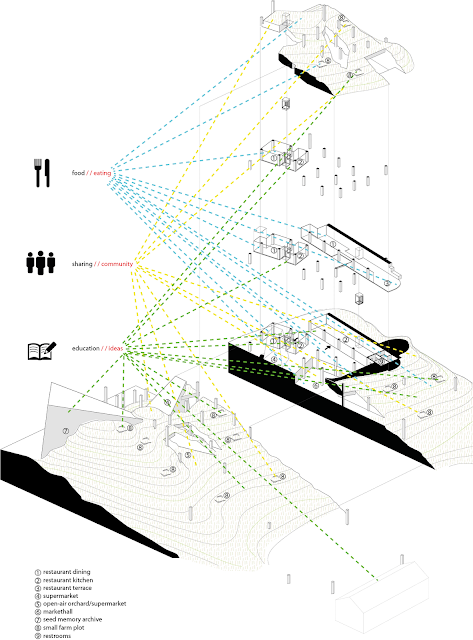Overall, I was fairly pleased with the project. I think that the need for a community driven space for interaction and social exchange is crucial in times of mass-media and a downturn in traditional social wayfinding locators and in turn, locations.
By identifying and revealing the currently hidden process of food production/processing/transport, it is possible to proximate the everyday or local issues that ask questions like "where does my food come from? How is it grown? How can I cook with it?" A localised food production agenda is something community members can aspire to and use as a building block to better learn about ecological, efficient and delicious food.
As an ambition; local food growth, cooking and leisure in a surreal environment of rural reminiscence is all a tool to translate or abstract the global concerns which impede and alienate social exchange within communities.
The building recreates this through a series of metaphors, framed views and particular emotions induced by architectural delights.
The overall concept of a community food exchange for trading food, meals, ideas and knowledge is met with an undulating landscape broken up to reveal the top down and bottom up process of local and global ideals.
All-in-all, I would like to spend a number of weeks recreating the project without the pressure of time. Perhaps I would begin by incorporating a number of ideas that have since been developing in my mind, or been suggested to me by valued peers. Which, I think, is something I have learned over the last four years to be one of the most valuable tools in architectural design workflow.
I have also taken away from this unit a yearning to maintain and continue developing the theme of local and global concerns. While I don't believe the architecture of one building can solve all the world's problems; merely the premise of raising concern is enough to get the proverbial ball rolling. So, to summarise I would like to quote again David Hogarth, as a challenge to contemporary architecture, connecting in perfect hetereotopia - "the abstract global and the proximate everyday or local."
Thanks to my class peers, Peter and Yasu, for the fantastic semester!
By identifying and revealing the currently hidden process of food production/processing/transport, it is possible to proximate the everyday or local issues that ask questions like "where does my food come from? How is it grown? How can I cook with it?" A localised food production agenda is something community members can aspire to and use as a building block to better learn about ecological, efficient and delicious food.
As an ambition; local food growth, cooking and leisure in a surreal environment of rural reminiscence is all a tool to translate or abstract the global concerns which impede and alienate social exchange within communities.
The building recreates this through a series of metaphors, framed views and particular emotions induced by architectural delights.
The overall concept of a community food exchange for trading food, meals, ideas and knowledge is met with an undulating landscape broken up to reveal the top down and bottom up process of local and global ideals.
All-in-all, I would like to spend a number of weeks recreating the project without the pressure of time. Perhaps I would begin by incorporating a number of ideas that have since been developing in my mind, or been suggested to me by valued peers. Which, I think, is something I have learned over the last four years to be one of the most valuable tools in architectural design workflow.
I have also taken away from this unit a yearning to maintain and continue developing the theme of local and global concerns. While I don't believe the architecture of one building can solve all the world's problems; merely the premise of raising concern is enough to get the proverbial ball rolling. So, to summarise I would like to quote again David Hogarth, as a challenge to contemporary architecture, connecting in perfect hetereotopia - "the abstract global and the proximate everyday or local."
Thanks to my class peers, Peter and Yasu, for the fantastic semester!




















































